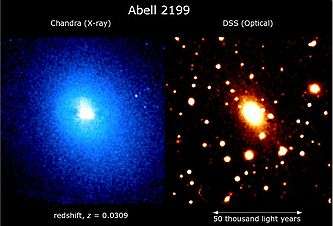Intracluster medium

In astronomy, the intracluster medium (ICM) is the superheated plasma present at the center of a galaxy cluster. This gas is heated to temperatures of the order of 10 to 100 megakelvins and composed mainly of ionized hydrogen and helium, containing most of the baryonic material in the cluster. The ICM strongly emits X-ray radiation.
Heating
The ICM is heated to high temperatures by the gravitational energy released by the formation of the cluster from smaller structures. Kinetic energy gained from the gravitational field is converted to thermal energy by shocks. The high temperature ensures that the elements present in the ICM are ionised. Light elements in the ICM have all the electrons removed from their nuclei.
Composition
The ICM is composed primarily of ordinary baryons (mainly ionised hydrogen and helium). This plasma is enriched with heavy elements, such as iron. The amount of heavy elements relative to hydrogen (known as metallicity in astronomy) is roughly a third of the value in the sun. Most of the baryons in the cluster (80-95%) reside in the ICM, rather than in the luminous matter, such as galaxies and stars. However, most of the mass in a galaxy cluster consists of dark matter.
Although the ICM on the whole contains the bulk of a cluster's baryons, it is not very dense, with typical values of 10−3 particles per cubic centimeter. The mean free path of the particles is roughly 1016 m, or about one lightyear.
The strong gravitational field of clusters means that they can retain even elements created in high-energy supernovae. Studying the composition of the ICM at varying redshift (which results in looking at different points back in time) can therefore give a record of element production in the universe if they are typical.[1]
Observing
As the ICM is at such high temperatures, it mostly emits X-ray radiation by the bremsstrahlung process and X-ray emission lines from the heavy elements. These X-rays can be observed using an X-ray telescope. Depending on the telescope, maps of the ICM can be made (the X-ray emission is proportional to the density of the ICM squared), and X-ray spectra can be obtained. The brightness of the X-rays tells us about the density of the gas. The spectra allow temperature and metallicity of the ICM to be measured.
The density of the ICM rises towards the centre of the cluster with a strong peak. In addition, the temperature of the ICM typically drops to 1/2 or 1/3 of the outer value in the central regions. The metallicity rises from the outer region towards the centre. In some clusters (e.g. the Centaurus cluster) the metallicity of the gas can rise above that of the sun.
Cooling flow
As the ICM in the core of many galaxy clusters is dense, it emits strong X-ray radiation (the emission is proportional to the density-squared). In the absence of heating, the ICM should be cooling. As it cools, hotter gas will flow in to replace it. This is known as a cooling flow. The cooling flow problem is the lack of evidence of cooling of the ICM.
See also
References
- ↑ Loewenstein, Michael. Chemical Composition of the Intracluster Medium, Carnegie Observatories Centennial Symposia, p.422, 2004.